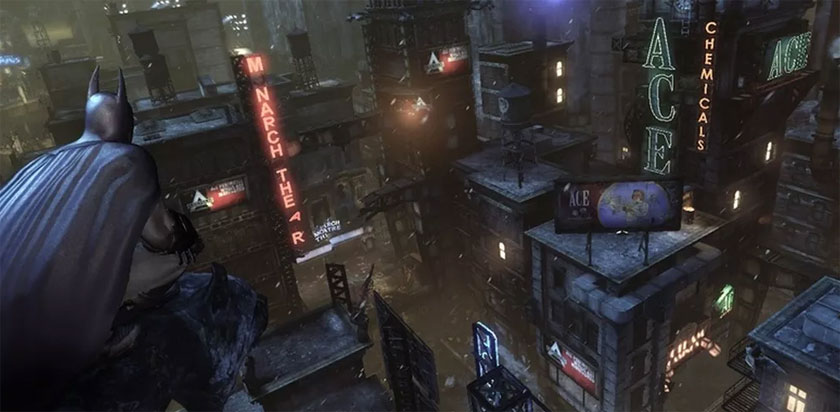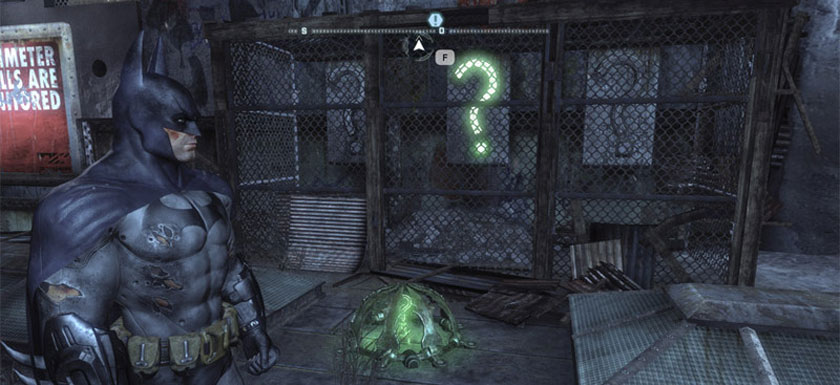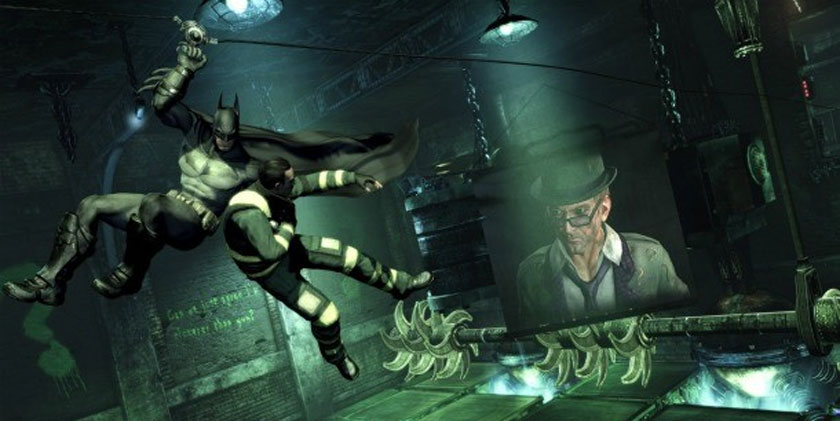“Distraction” is the Theme of Arkham City’s Gameplay

I recently decided to revisit Batman: Arkham City the other day, inspired by rereading many of Shamus Young’s excellent analyses and essays regarding the caped crusader’s most popular game franchise. That it would be one of Shamus’ favorite game series, one in which he devoted hours to mastering and perfecting its combat, has always fascinated me. Don’t ask me to explain why, as I don’t think I have a suitable explanation. It just doesn’t seem to be a “very Shamus-y” title, and yet it’s one in which he is frequently comparing other games.
I myself have played the original Arkham Asylum several times – including a recent trip back last year to help ease the pain of unemployment – but I’ve only taken maybe two trips around the generally favored Arkham City since its release. I’ve always favored the former due to a preference for the linear gameplay design, taking inspiration from personal favorites such as Metroid Prime or – intentionally or coincidentally – the original Resident Evil. Smaller worlds and environments that you explore more intimately are more my cup of tea than sprawling cities or open-worlds behaving as obstacle-courses.
It’s that very open-world design that I imagine made Arkham City a favorite among the fanbase, however. Having played through the game again, I feel even more confident in the assertion that the sprawling urban playpen is what curries such player favor and fervor. What I also came to realize, however, was the nature in which this expanded scope would impact not just my enjoyment of the game’s world, but also its narrative.
One of Shamus Young’s gripes about the story of Arkham City is how swiftly Batman gets distracted from his main goal: uncovering the plot of Hugo Strange’s Protocol Ten. This is the established over-arching threat and objective before Bruce Wayne even has a chance to put his cowl on and transform into the much feared Caped Crusader. Just as the Bat-belt is Bat-strapped around Batman’s raw-muscle Bat-waist, however, he receives word that Catwoman is being held by Two-Face and at risk of a public execution. Joker attempts a kitty-cat assassination the moment Two-Face’s farce of a trial is foiled. This ultimately leads Batman into a trap wherein he is injected with the Clown Prince of Crime’s degenerating and debilitating blood. As a result, nearly the whole game is spent focusing on every super villain but Hugo Strange.
Mechanically speaking, however, the distractions start once Batman begins gliding off the rooftop of ACE Chemicals. A big glowing green button is placed directly in the path between Batman’s heightened location and the courthouse where Catwoman is being held, drawing the player’s attention to it more than the run-down government building Two-Face has occupied. Once the player steps on the button – the most obvious choice of interaction – a nearby cage pops open to reveal the first Riddler Trophy of the game.
It’s here that new players to the game will learn about the optional Riddler Challenges scattered – or more appropriately, splattered – all over the game world, and perhaps even learn that these switches are not always so simple as they first appear. If the player steps off the button, a countdown begins before the cage snaps shut over the trophy once more. The player must sprint towards the trophy if they wish to retrieve it in time. Alternatively, more experienced or experimental players will know to swap out to the Bat-claw, lashing the grappling hook out to snatch the trophy from a distance.

Which leads me not only to my personal issue with Arkham City, but also why I believe it’s so popular among other players. If you know what you’re doing, then the player is free to begin playing in the world as soon as they’re in the Batsuit. This means returning players don’t have to go through hours of tutorials before they can begin beating up thugs and collecting Riddler trophies. Just as Batman will soon begin ignoring the urgency of Hugo Strange’s Protocol 10, so too can the player ignore the urgency of… well, of anything in favor of tossing Batarangs at the wall, dive-bombing onto criminals, or hoping from button to button. These challenges are also where the more skilled, mechanics-driven players are bound to find the most interesting gameplay. Nowhere in the main story is the player required to fly towards a specific spot on the wall, press off towards another very specific spot on the opposite wall, and then likely do it again on the final button. In fact, it probably sounds awfully silly describing it in just that manner. However, not only is it an example of one of the challenges players will be asked to perform in order to obtain a trophy, it’s one of the easier challenges to complete. That such a comparatively simple task is more complex than anything in the campaign means those skill-driven players are going to be inclined to jump into the world as early and as often as possible.
Not that the player is without limitations. The majority of the challenges across the city demand gadgets that have yet to be obtained or unlocked without completion of the story.
On one hand, it seems a bit hypocritical that I dislike this aspect of Arkham City after stating how much I enjoy it in Arkham Asylum. After all, having to backtrack to old locations only after you’ve gotten the required gear to open a door or obtain a secret treasure is a part of the appeal. The key difference between the two experiences is in scope, both in size of the game world and in the sheer quantity of challenges to keep track of. There’s far less asylum than there is city, and thus it becomes easier to mentally map any items or obstacles you can’t yet obtain or overcome. Most of the time spent in Arkham City is on rooftops, where the glowing green question marks demand the player’s attention far more than the buildings and billboards of the city itself. It’s simply too much to keep track of in a far larger space.
To paraphrase Game Director Sefton Hill, it seems as if Rocksteady had included so many challenges and trophies simply because they could. Before reading that interview, I had assumed that the challenges and trophies were so frequent and obvious in order to guarantee players had a steady drip feed of dopamine and experience, granting them opportunities to feel accomplishment while simultaneously providing them a manner to level up swiftly. After all, players less skilled at combat won’t be able to obtain as much experience from combo bonuses or gadget variety. Littering the city skyline and every building interior with an abundance of trophies ensures that all players have a fair chance of earning upgrades throughout the game.

Instead, Sefton suggests a far more vague sense of stuffing each district and location with whatever amount of trophies and challenges “felt right”. This seems to also lend to the inclusion of so many villains, many of whom will drag Batman’s attention away from the main quest. No matter which playthrough I’m on, for example, Victor Zsasz calls just as I’m about to try and walk into the abandoned Gotham Police Department. This may have only been my third playthrough, but the startled confusion of the telephone had become so etched into my memory as to feel akin to déjà vu. It leads me to believe that the phone call is scripted to occur at that moment in time, meaning the game designers themselves were intentionally yanking the player’s attention away from the main campaign.
Despite the clock ticking down towards both Protocol 10 and Joker’s toxic blood killing Batman and those infected in the surrounding hospitals, the game will frequently demand the player sprint and glide across the city for Zsasz’s ringing telephones, establishing a crime scene to scan Deadshot’s latest victims, or solving the mystery of the faceless victims of Hush. While such side quests are optional, each of these tertiary members of Batman’s rogue’s gallery will be vying for the Crusader’s attention just as much – if not more so – than the core narrative.
In other words, it’s not just the plot that tries to pull Batman away from Hugo Strange’s Protocol 10. The gameplay itself seems far more interested in pulling the player’s attention away from the campaign and into its myriad distractions. This leaves me, personally, without a clear sense of direction of what I ought to be doing. Most open-world games feel to me as if they have very clear moments of downtime where the player can roam about and do optional content for a while. Their narrative beats are designed far more episodically rather than the relentless pace Arkham City pushes the player forward. Or, in the case of the Yakuza games, there’s only so many side missions available within a given chapter, only unlocking select quests once you’ve progressed through the story enough.
While this approach to relentlessly calling the player’s attention to its optional content overwhelms me compared to the smaller-scaled Arkham Asylum, I am at least willing to understand how it’s appealing to other players. This is especially in light of how surprisingly short the game’s narrative is, allowing the player to focus the majority of their time instead on the Riddler challenges and super villains as “post-game content”. By burning through the narrative you can “unlock” the world and all of Batman’s gadgets without some of the more egregious snipers and foes littering the landscape. There’s still ample challenge to be found, but not so much as to get in the way of exploration. It allows the player a more pure opportunity of being Batman, unmarred by the reminder that you really ought to be stopping the Joker or Hugo Strange.
Next entry I’ll be discussing the manner in which this distraction element plays into the different characters, and fails to stitch together a coherent theme.


